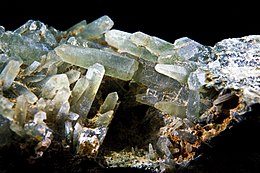Prasiolite
| Prasiolite | |
|---|---|
 | |
| General | |
| Category | Oxide mineral |
| Crystal system | Trigonal |
| Identification | |
| Color | shades of green |
| Crystal habit | Hexagonal prisms |
| Cleavage | None |
| Fracture | Conchoidal[1] |
| Tenacity | brittle[1] |
| Mohs scale hardness | 7 – lower in impure varieties[1] |
| Diaphaneity | Transparent to nearly opaque |
| Specific gravity | 2.65 |
| Refractive index | 1.544 to 1.553[2] |
| Birefringence | 0.009[3] |
| Ultraviolet fluorescence | none |
Prasiolite (also known as green quartz or vermarine) is a green variety of quartz, a silicate mineral chemically silicon dioxide.
Since 1950, almost all natural prasiolite has come from a small Brazilian mine, but it is also seen in Lower Silesia in Poland. Naturally occurring prasiolite is also found in the Thunder Bay area of Canada.[4]
Most prasiolite sold is used in jewellery settings, where it can substitute for far more expensive precious gemstones.
It is a rare stone in nature; artificially produced prasiolite is heat treated amethyst.[4] Most amethyst will turn yellow or orange when heated producing citrine. But some amethyst will turn green when treated. Currently, almost all prasiolite on the market results from a combination of heat treatment and ionizing radiation.[5]
Green quartz is sometimes incorrectly called green amethyst, which is not an acceptable name for the material, the proper terminology being prasiolite.[6] It is actually against Federal Trade Commission Guidelines to call prasiolite "green amethyst". Other names for green quartz are vermarine, greened amethyst, or lime citrine.
The word prasiolite literally means "scallion green-colored stone" and is derived from Greek πράσον prason meaning "leek" and λίθος lithos meaning "stone". The mineral was given its name due to its green-colored appearance.
Natural prasiolite is a very light, translucent green. Darker green quartz is generally the result of artificial treatment.[7]
See also
References
- ^ a b c "Prasiolite gemstone information". www.gemdat.org. Retrieved 19 April 2018.
- ^ Lazarelli. Blue Chart Gem Identification. p. 7.
- ^ "PRASIOLITE the green variety of quartz (aka Green Amethyst)". www.galleries.com. Retrieved 19 April 2018.
- ^ a b "Prasiolite". quarzpage.de. 28 October 2009. Retrieved 28 November 2010.
- ^ "Mineral Spectroscopy Server". California Institute of Technology. 11 June 2012. Retrieved 10 December 2012.
- ^ "Green Amethyst". GemSelect. Retrieved 10 December 2012.
- ^ Gems and Gemstones: Timeless Natural Beauty of the Mineral World By Lance Grande, Allison Augustyn, p.91
External links
